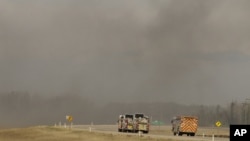Scientists say wildfires like the one that burned parts of Fort McMurray and continues to burn in the boreal forest regions of Alberta, Canada are going to become more common thanks to the continuing effects of climate change.
The fire in Canada has forced the evacuation of 88,000 people, and cut the nation's oil production by nearly a third due to its advance on the oil boomtown.
New research from University of Montana scientists suggest climate change will make the northern boreal forests the U.S. state of Alaska and other high latitudes particularly vulnerable to fires and so-called "super fires" like the one in Canada.
Warmer, Drier Equals More Fire
Climate scientists have long predicted that as the planet gets warmer the northern latitudes will get warmer faster than other regions.
University of Montana affiliate scientist Adam Young and Fire Ecology Associate Professor Philip Higuera ran some numbers on what that means for the boreal forest and tundra regions. They focused on Alaska, but their research has implications for regions all of the high latitude regions of the earth.
They found the risk of fire up north will like increase up to 4 times compared to recent decades.
"We looked at the location of wildfires across Alaska during the past 60 years and, not surprisingly, found that they were most common in regions with warm, dry summers," Young said.
But they also found that areas where the temperatures stayed moderate, even in drier conditions were less likely to catch fire. As regions get warmer Young says, "We see a sharp increase in the likelihood that a fire will occur in a region."
More Warming, More Fire, More Carbon
And this creates a huge negative feedback loop that pumps more and more carbon into the sky.
The Boreal forests and Tundra in the northern parts of the planet are huge carbon sinks. They store up to 50 percent of the Earth's total soil carbon.
Fires will push a lot of that carbon back into the atmosphere, increasing the concentration of climate changing gases in the atmosphere.
Their research has been accepted for publication in the journal Ecography: Pattern And Diversity in Ecology.









